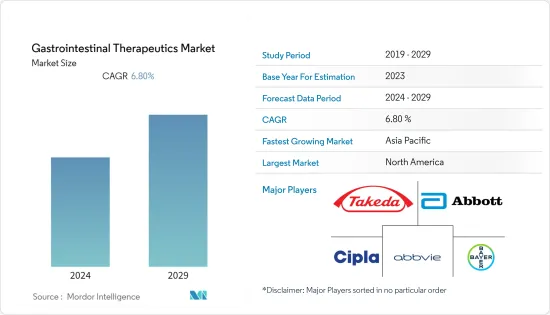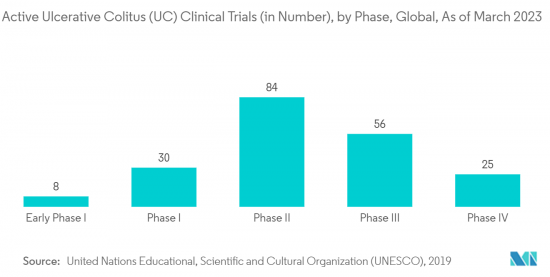PUBLISHER: Mordor Intelligence | PRODUCT CODE: 1404406

PUBLISHER: Mordor Intelligence | PRODUCT CODE: 1404406
Gastrointestinal Therapeutics - Market Share Analysis, Industry Trends & Statistics, Growth Forecasts 2024 - 2029

The gastrointestinal therapeutics market is expected to register a CAGR of 6.8% over the forecast period.
COVID-19 significantly impacted the market growth owing to the correlation between gastrointestinal diseases and coronavirus infection. For instance, according to an article on the SARS-CoV-2 virus, it may affect the digestive tract, and people with the disease are most at risk for negative effects. In addition, as per the same source, certain repurposed medications used to treat COVID-19 can harm the liver and cause or exacerbate some gastrointestinal symptoms connected to the virus. Also, the pandemic led to a shortage and supply of gastrointestinal drugs, impacting the market growth. However, with the released restrictions and resumed supply and chain services, the demand for gastrointestinal drugs increased, and the studied market witnessed significant growth. It is expected to grow over the forecast period.
Factors such as the increasing prevalence of gastrointestinal diseases and the rising investments in research and development by pharmaceutical companies are expected to boost the market growth.
The increasing burden of gastrointestinal diseases among the population raises the demand for effective drugs, which is expected to fuel market growth. For instance, as per the 2022 statistics published by the IARC, about 1.15 million new colon cancer cases were reported during the pandemic, which is expected to rise to 1.82 million by 2040. Also, the 2022 update by Bower Cancer United Kingdom shows that bowel cancer is the fourth most common cancer, and approximately 43,000 people are diagnosed with bowel cancer every year in the United Kingdom.
Additionally, as per an article published in NLM in July 2022, it was observed that GERD, the most prevalent gastrointestinal condition, affects 20% of individuals in Western culture. In addition, as per the same source, an estimated prevalence of GERD in the United States ranges between 18.1% and 27.8%, and the prevalence of GERD is higher among men than women. Similarly, as per an article published in PLOS One in April 2021, it was observed that the overall prevalence of hemorrhoids was higher in the male population in Northwest Ethiopia. The risk of having hemorrhoids was shown to be higher in people who were overweight and had constipation problems. Thus, the high burden of hemorrhoids among the population is anticipated to increase the demand for gastrointestinal drugs, which is anticipated to augment the market growth over the forecast period. Thus, the high prevalence of hemorrhoids and GERD among the population increases the demand for gastrointestinal drugs, bolstering market growth.
Furthermore, the rising company's investment in research and development of gastro-related drugs and rising drug launches that increase the availability of the drugs in the market are also expected to fuel the market growth. For instance, in April 2022, Microbiotica received project funding from the Crohn's & Colitis Foundation, as part of their IBD Ventures program, for the development of therapies, Microbiotica's Live Bacterial Therapeutic (LBT) MB310 to treat ulcerative colitis or inflammatory bowel disease (IBD). The funding is utilized to advance MB310's development through cGMP production to support an investigational new drug (IND) application, which allows entry into a first-in-human clinical study.
Moreover, the rising company activities in developing novel drugs and increasing product launches are also contributing to the market growth. For instance, in April 2022, Ardelyx, Inc. launched IBSRELA, an NHE3 inhibitor for treating irritable bowel syndrome with constipation (IBS-C) in adults. Also, in March 2021, Lupin launched a generic version of Alinia (nitazoxanide) tablets, 500 mg of Romark Laboratories in the United States. Nitazoxanide is indicated in treating diarrhea caused by Giardia lamblia or Cryptosporidium parvum in patients 12 and older.
Therefore, owing to the factors above, the studied market is anticipated to grow over the forecast period. However, the rising socio-economic burden associated with GI disorders and the increasing number of patent expiry products will likely impede the growth of the gastrointestinal therapeutics market over the forecast period.
Gastrointestinal Therapeutics Market Trends
Ulcerative Colitis Segment is Expected to Witness Significant Growth Over the Forecast Period
Ulcerative colitis is a chronic inflammatory bowel disease (IBD) that causes inflammation and ulcers on the inner lining of the large intestine due to abnormal immune system reactions. Some drugs used to treat ulcerative colitis are Infliximab, Humira, Simponi, Entyvio, Stelara, Colazal, Dipentum, Azulfidine, and others.
The ulcerative colitis segment is expected to witness significant growth in the gastrointestinal therapeutics market over the forecast period owing to factors such as the high burden of ulcerative colitis and rising company activities.
According to an article published in Gastroenterology Journal in January 2023, biological drugs significantly altered the IBD treatment plan. Yet, many patients still need alternative treatments owing to ineffectiveness or side effects. In addition, it was observed that translational research emphasized the promise of new therapeutic concepts, such as modulating host-microbiome interactions, stem therapy for perianal fistula, controlling immune cells that were previously less targeted, and regulating fibrosis. They were used to develop effective drugs for the treatment of ulcerative colitis. Thus, the rising new and emerging treatments are expected to increase the availability of effective and safe drugs in the market, boosting segment growth.
Furthermore, the increasing drug approval and launches by regulatory bodies are expected to increase the availability of novel therapeutics for treating ulcerative colitis patients. It is anticipated to fuel the market growth over the forecast period. For instance, in December 2022, the United States FDA accepted Pfizer's New Drug Application (NDA) for etrasimod, an oral, once daily, selective sphingosine-1-phosphate (S1P) receptor modulator. It is designed for optimized pharmacology and S1P receptors 1, 4, and 5 engagement for individuals with moderately-to-severely active ulcerative colitis (UC). Also, in May 2021, Bristol Myers Squibb received United States FDA approval for Zeposia (ozanimod) to treat moderate to severely active ulcerative colitis in adults.
Therefore, owing to the factors above, the studied segment is expected to grow over the forecast period.

North America is Expected to include the Significant Market Share Over the Forecast Period
North America is expected to hold a significant market share over the forecast period owing to factors such as the increasing burden of gastrointestinal diseases, rising product launches, and growing company initiatives.
The increasing burden of gastrointestinal diseases such as stomach cancer, colon cancer, GERD, ulcerative colitis, and others among the population is the key factor driving the market growth. For instance, according to 2023 statistics published by the ACS, about 153,020 new cases of colon-rectal cancer are expected to be diagnosed in the United States in 2023. Also, as per an article published in NLM in July 2022, GERD was one of the most widespread gastrointestinal conditions, affecting 20% of adults in Western countries such as the United States. In addition, the estimated prevalence of GERD in the United States population ranges from 18.1% to 27.8%. Additionally, according to the Canadian Cancer Society (CCS) data reviewed in May 2022, colorectal cancer was expected to be Canada's fourth most commonly diagnosed cancer in 2022. Also, nearly 24,300 Canadians were diagnosed with colorectal cancer, representing 10% of all new cancer cases in Canada in 2022.
Furthermore, the rising government funding for gastrointestinal diseases research and development is expected to increase the company's focus on developing novel treatment drugs, propelling market growth. For instance, according to the data published by NIH, in May 2022, the government funded an estimated USD 352 million for the research and development of colorectal cancer disease in the United States in 2022, compared to USD 335 million in 2021. In addition, as per the same source, an estimated USD 92 million was funded by the government for research and development of Crohn's disease in 2022 as compared to USD 88 million in 2021.
Moreover, the rising drug launches and approvals in the region and an increasing company focus on adopting key strategies such as collaboration, partnerships, and others are also contributing to the market growth. For instance, in March 2022, AbbVie Inc. received United States FDA approval for its RINVOQ (upadacitinib) prescription medicine for treating adults' severe to moderate ulcerative colitis. Also, in October 2022, Phathom Pharmaceuticals signed a deal with Evonik to manufacture its recently FDA-approved gastrointestinal drug, vonoprazan. Similarly, in May 2021, BMS received United States FDA approval for Zeposia, a sphingosine 1-phosphate (S1P) receptor modulator, to treat moderate to severe ulcerative colitis.
Therefore, owing to the factors above, the studied segment is expected to grow over the forecast period.
Gastrointestinal Therapeutics Industry Overview
The gastrointestinal therapeutics market is moderately competitive. The companies are adopting key strategies such as new product development, collaborations, partnerships, and others to retain their market position. Some market players include Abbott Laboratories, Abbvie Inc., Cipla Inc., Bayer AG, GlaxoSmithKline PLC, Janssen Pharmaceuticals Inc. (Johnson & Johnson), and Takeda Pharmaceutical Company Limited.
Additional Benefits:
- The market estimate (ME) sheet in Excel format
- 3 months of analyst support
TABLE OF CONTENTS
1 INTRODUCTION
- 1.1 Study Assumptions and Market Definition
- 1.2 Scope of the Study
2 RESEARCH METHODOLOGY
3 EXECUTIVE SUMMARY
4 MARKET DYNAMICS
- 4.1 Market Overview
- 4.2 Market Drivers
- 4.2.1 Increasing Prevalence of Gastrointestinal Diseases
- 4.2.2 Rising Investments in Research and Development by Pharmaceutical Companies
- 4.3 Market Restraints
- 4.3.1 Rising Socio-economic Burden Associated with Gastrointestinal Disorders
- 4.3.2 Increasing Number of Patent Expiries
- 4.4 Porter's Five Forces Analysis
- 4.4.1 Bargaining Power of Suppliers
- 4.4.2 Bargaining Power of Buyers/Consumers
- 4.4.3 Threat of New Entrants
- 4.4.4 Threat of Substitute Products
- 4.4.5 Intensity of Competitive Rivalry
5 MARKET SEGMENTATION (Market Size by Value - USD)
- 5.1 By Drug Type
- 5.1.1 Antacids
- 5.1.2 Laxatives
- 5.1.3 Antidiarrheal agents
- 5.1.4 Antiemetics
- 5.1.5 Antiulcer agents
- 5.1.6 Other Drug Types
- 5.2 By Dosage Form
- 5.2.1 Oral
- 5.2.2 Parenteral
- 5.2.3 Other Dosage Forms
- 5.3 By Application
- 5.3.1 Ulcerative Colitis
- 5.3.2 Irritable Bowel Syndrome
- 5.3.3 Crohn's Disease
- 5.3.4 Celiac Disease
- 5.3.5 Gastroenteritis
- 5.3.6 Other Applications
- 5.4 By Geography
- 5.4.1 North America
- 5.4.1.1 United States
- 5.4.1.2 Canada
- 5.4.1.3 Mexico
- 5.4.2 Europe
- 5.4.2.1 Germany
- 5.4.2.2 United Kingdom
- 5.4.2.3 France
- 5.4.2.4 Italy
- 5.4.2.5 Spain
- 5.4.2.6 Rest of Europe
- 5.4.3 Asia-Pacific
- 5.4.3.1 China
- 5.4.3.2 Japan
- 5.4.3.3 India
- 5.4.3.4 Australia
- 5.4.3.5 South Korea
- 5.4.3.6 Rest of Asia-Pacific
- 5.4.4 Middle East and Africa
- 5.4.4.1 GCC
- 5.4.4.2 South Africa
- 5.4.4.3 Rest of Middle East and Africa
- 5.4.5 South America
- 5.4.5.1 Brazil
- 5.4.5.2 Argentina
- 5.4.5.3 Rest of South America
- 5.4.1 North America
6 COMPANY PROFILES AND COMPETITIVE LANDSCAPE
- 6.1 Company Profiles
- 6.1.1 Abbott Laboratories
- 6.1.2 Abbvie Inc.
- 6.1.3 AstraZeneca
- 6.1.4 Bayer AG
- 6.1.5 GlaxoSmithKline PLC
- 6.1.6 Janssen Global Services LLC (Johnson & Johnson)
- 6.1.7 Pfizer Inc.
- 6.1.8 Takeda Pharmaceutical Company Limited
- 6.1.9 Bausch Health Companies Inc. (Salix Pharmaceuticals Inc.)
- 6.1.10 Boehringer Ingelheim International GmbH
- 6.1.11 Cipla Inc.
- 6.1.12 Sebela Pharmaceuticals
7 MARKET OPPORTUNITIES AND FUTURE TRENDS




